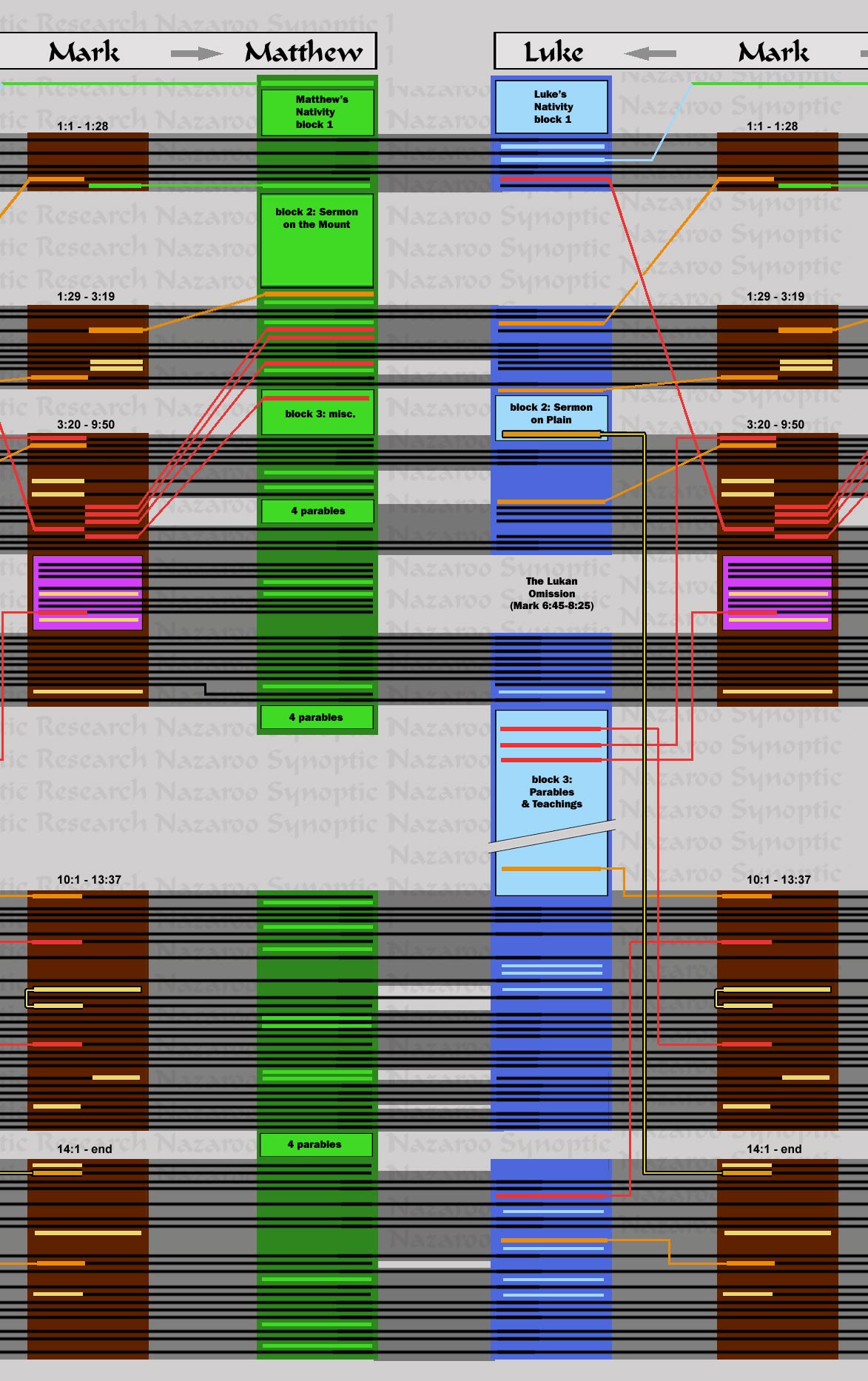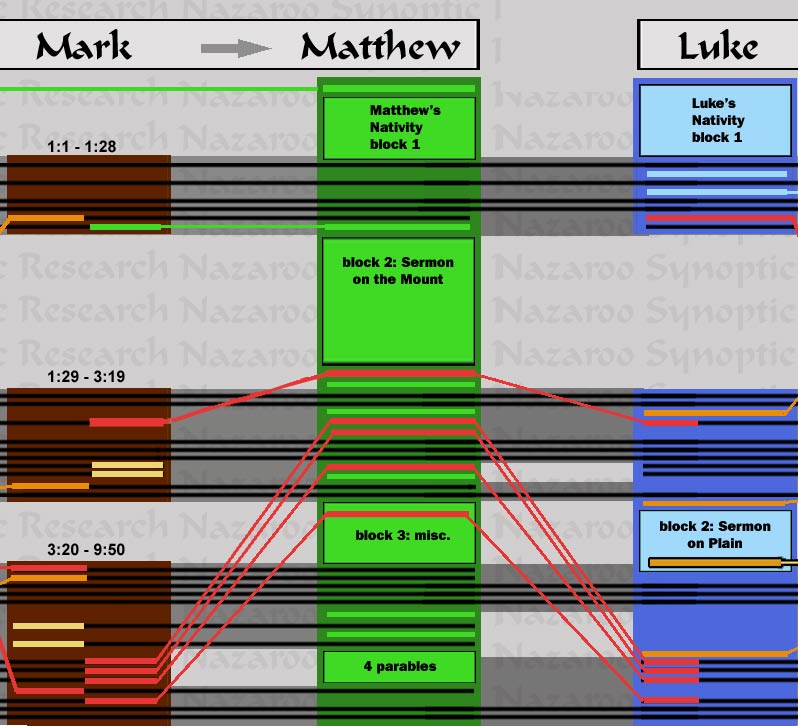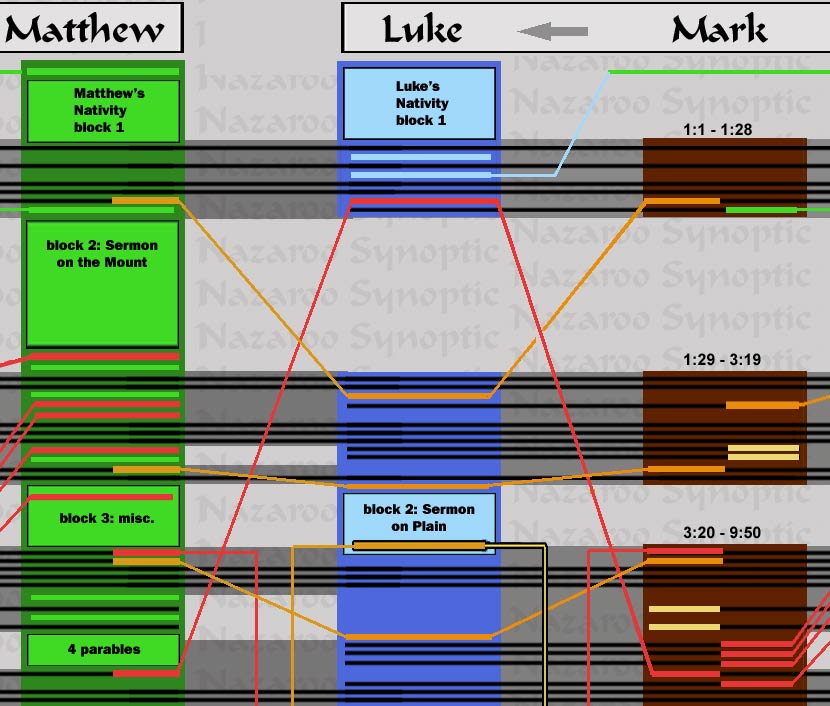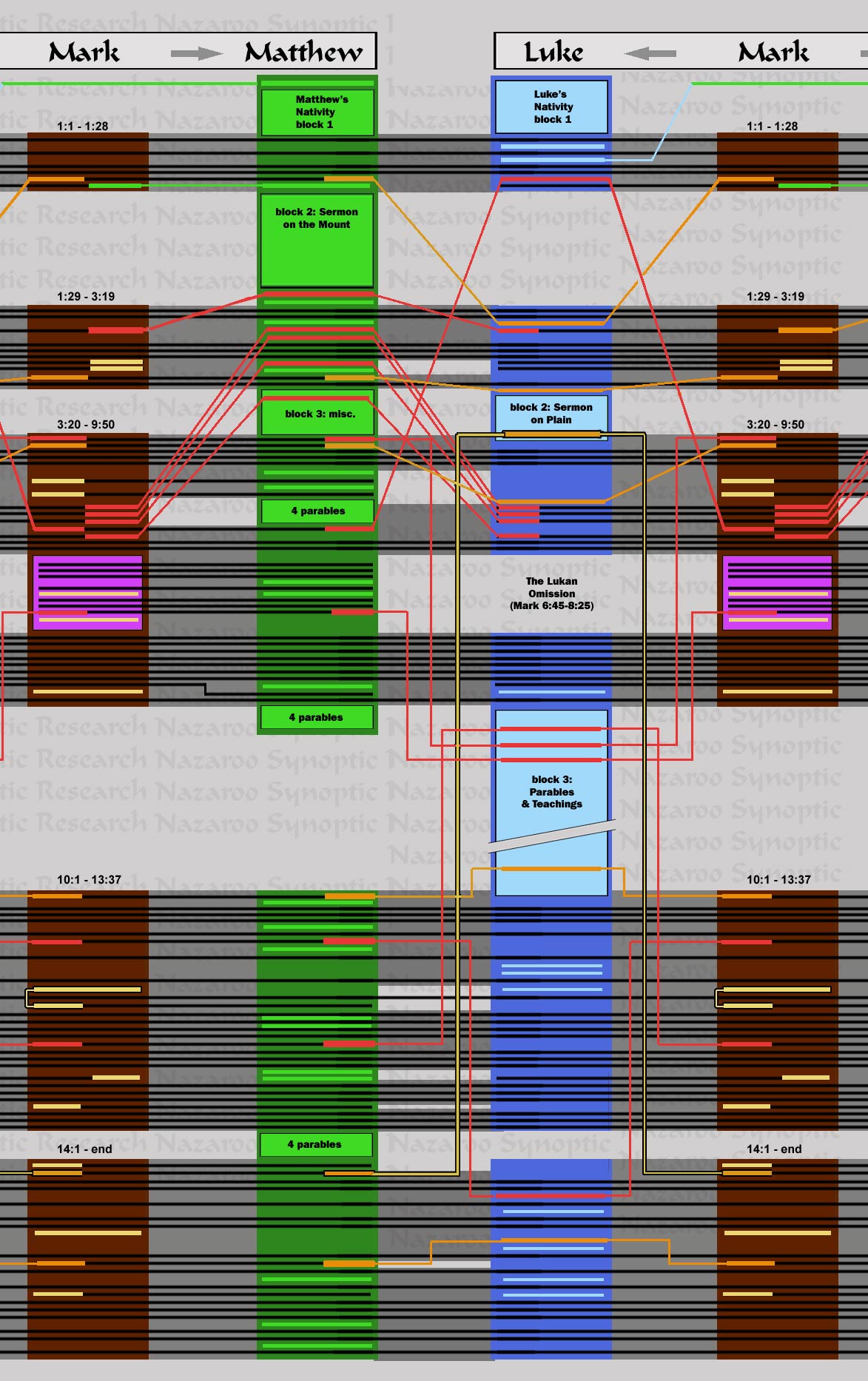Page Index
Last Updated: Jan. 02, 2008
Section 1: - Introduction to Matthew & Luke
Matthew & Luke - (chart)
Section 2: - Matthew's Dislocations of Mark
Matthew's Dislocations - (chart)
Section 3: - Luke's Dislocations of Mark
Luke's Dislocations - (chart)
Section 4: - Dislocations: Final Chart
INTRODUCTION
Next we may benefit by considering how Luke and Matthew are related to one another.
How Luke and Matthew used Mark
The best way to proceed is first to consider how each editor (Luke and Matthew) used Mark.
Luke plainly seems to have used Mark as a base. But if Matthew also reproduces 90% of Mark, and if Luke also reproduces material also found in Matthew, then isn't it possible that Luke has simply used Matthew (or vise versa)?
The answer is no, not really. On the one hand, Luke reproduces almost all of Mark in some form or other, and also (with the five exceptions noted) follows closely Mark's order of events, even against Matthew, who does even less rearranging of Mark than Luke.
The two great editors, Luke and Matthew, each handle Mark quite independantly, as to what they omit, and what they rearrange.
Each of them however (Luke and Matthew), is much more closely and directly related to Mark than to each other's 'version' of Mark's material.
As we saw previously, Luke's treatment of Mark is actually quite simple: He inserts his other material in three large blocks, breaking Mark up into three chunks. Then Luke also inserts a few small stories here and there, and rearranges the order of a few incidents.
Matthew's treatment of Mark is also nearly as simple. He breaks Mark up in a few more places, in order to insert more (but smaller) blocks of material (usually groups of parables).
The result of their independant activity is rather predictable. The parts of Mark that they share for the most part remain in Mark's order.
When Matthew or Luke depart from Mark's order, they do it alone.
This is remarkable and important. It shows that at least one of them did not know of the other, and did not copy directly from him. And it shows that the other was equally unconcerned with the chronological changes introduced by his predecessor.
Finally, we cannot reconstruct Mark by simply comparing Luke and Matthew. We can however, use Mark to demonstrate quite clearly what each editor (Luke/Matthew) has done.
Secondly, (also quite predictably), the parts of Mark preserved by BOTH Luke and Matthew are much more broken up and isolated as a result of independant editing and rearrangment by the two.
New Chart with Matthew & Luke in Centre
We can see this secondary fragmentation by inverting our previous chart, and putting Mark on the OUTSIDE, with Matthew and Luke in the middle (next to each other).
With this arrangement we can first note the parts of Mark that both Matthew and Luke share and reproduce without dislocation. We see more 'holes' created in Mark, where each of our editors has independantly omitted or relocated material (look at the black horizontal lines and grey blocks between Matthew and Luke - these represent the Markan material):
Matthew & Luke Together

Matthew's Dislocations of Mark
Matthew Alone Is Responsible for Matthew's Dislocations
With Matthew in the middle, the dislocations that Matthew is responsible for are quite obvious:
In each case, Matthew combines the piece with new material he wishes to work in and legitimize, providing a context and background. Although five sections are moved, actually only four instances of Matthew's dislocation occur, since he treats two consecutive sections as a single piece:
Synoptic Chart with Matthew's Dislocations
Here we have laid out the basic relationship in a standard synoptic chart form:

Why Do We Know Matthew Made the Changes?
One alternate interpretation offered by those who prefer to hold to the priority of Matthew is as follows:
Mark himself could have edited Matthew (or the Hebrew/Aramaic Matthew), and is responsible for the appearance of dislocations in Greek Matthew. In this scenario, Luke then copied the Greek Mark, also copying the dislocations Mark made.
The other internal evidence does not seem to support this however: For one thing, what Matthew does is understandable, in that he wants to insert supplimental material, and so moves some things out of the way to insert four parables. He does not throw the Markan sections away however, but reinserts them elsewhere, as bridges and as a way of protecting and legitimizing other new material he is adding. All of this is the normal and expected procedure of a compiler and expander of the Gospel story.
The alternative, that Mark did the moving, seems preposterous (along with a massive amount of deleting!). We can give no intelligent account of what Mark's motives would be for deleting huge blocks of important teaching of Jesus (in any early version of Matthew) and other stories, only to save a few relatively mediocre incidents and reinsert them elsewhere.
Luke's Dislocations
of Mark
Having a basic understanding of the components in this relationship (see previous article), we can put it all together to present the overview.
If our readers have followed us so far, they should be able to look at the big picture with some real understanding of the relation between Luke and Mark:
Mark and Luke: Overview

Lukan Rearrangements of Markan Material
For similar reasons, Luke's chronological rearrangements are equally plain to us, although they are more extensive than Matthew's when it comes to Mark:
Mark and Luke: Overview

Independant Chronological Rearrangements
The basic point is, when it comes to relocating material, neither editor has copied the other. This is not to say that neither was aware of the other (one was clearly aware of the other's work, as will become apparent when we examine the NON-Markan material). It is even possible that BOTH were aware of the other's work, if they shared notes or had meetings before beginning.
There appears to be NO place where Luke and Matthew agree with each other chronologically against Mark! This is highly significant.
(We can discount the trivial case of the Nativity material agreeing chronologically, since Mark shows no knowledge or interest in it. This is not a true case of 'disagreement' of Matt/Luke against Mark.)
But if Matthew for instance followed Luke's general scheme to produce a 'super-gospel' or a supplimentary gospel, then it was only on the general planning level, and not in the specific details.
This does not necessarily imply that Mark's chronology is the most accurate, or even that Luke and Matthew viewed it as only needing a few minor changes. Nor can it reflect any opinion between Luke and Matthew of each other's chronological improvements.
On the one hand, the most likely situation is that one gospel writer wrote first, preventing him from consulting the other, or having knowledge of any chronological changes. It is then only the behaviour of ONE of the two editors that needs explaining.
Secondly, both authors seem to have had more than mere chronology in mind when rearranging and editing Mark. They both felt a freedom if not a need to 'improve' Marks' grammar and diction, and even his story-telling performance. In many cases, we see both Luke and Matthew independantly, but similarly editing Mark's stories, removing the superfluous, the confusing, the clumsy, or the irrelevant, while often expanding the explanatory and 'teaching' matter, for clarity.
Both Luke and Matthew provide supplementary material, such as the Nativity sections, not with the intent to supplant or substitute, but rather to augment the gospel and preserve important traditional material.
Similarly, while Matthew manages to retell some 606 verses of Mark out of about 661 (dropping only 10%) he also manages to swell these up to a new total of about 660 verses (Matthew totals about 1,068 verses, with 400 of them non-Markan material). That is, Matthew has added over 60 verses of extra 'explanatory' material to Mark, even though he often drastically cuts down Mark's wordy accounts!
Yet the vastly different methods of insertion and arrangements of NON-Markan material between Matthew and Luke require a separate treatment all their own.
Mark's divine inspiration seems not to have extended superstitiously to the very chronological order or the mode of expression of Mark's account, at least in the eyes of the other two evangelists. Instead, both editors felt free to 'improve' as well as suppliment Mark for the service of their new and different audiences.
That is, different groups of believers and different generations seem to have required a different form of 'gospel' than the one Mark left us, or at least the needs of the church and posterity demanded that other material not covered by Mark be preserved and presented in a new format and order.
We should keep in mind that Luke also provided a powerful and important history of the early church for us in his second book, the Book of Acts, while Matthew seems to have successfully subsumed and syncretized various strains of teaching found among the letters that the early Apostles left behind.
Matthew & Luke: Dislocations
